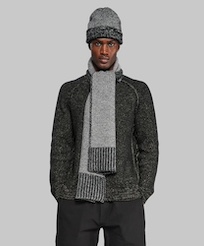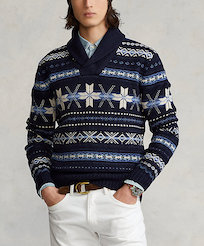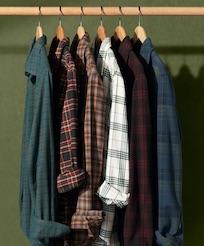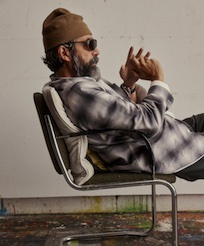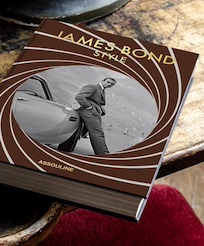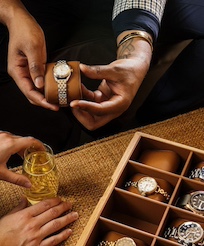The annual awards bestowed upon designers by the Council of Fashion Designers of America (CFDA) are some of the most prestigious in the industry, and thus, nominees are typically either established names working for major houses or extremely well-connected up-and-comers. But this year, alongside ever-present industry behemoths like Raf Simons and Marc Jacobs is a name few expected to see: Supreme founder James Jebbia. Two-and-a-half decades after launching the beloved label, he's been nominated for menswear designer of the year in addition to Simons, Thom Browne, Tom Ford, and Virgil Abloh of Off-White, a younger streetwear brand.
That the CFDA nominated not one but two streetwear brands seems a clear grab at appearing hip and remaining relevant (they're also holding the ceremony in Brooklyn and have tapped comedian Issa Rae of Insecure to host) that has nevertheless prompted many to wonder what this establishment attention could mean for a niche community that has, up until recently, largely existed on its own, mixing with the rest of the fashion industry proper only on select projects and occasions.
“The Awards should reflect the times,” Steven Kolb, President and CEO of the CFDA, said in a statement. “Having James and Virgil, two exciting talents, nominated reflects the crossroads of change that is happening in our industry. CFDA is proud that the members of our Awards Nominating Guild recognized that creativity is no longer just defined by traditional models of business, and were modern in their thinking.”
Since its inception in 1994, Supreme has spawned countless imitators while continuing to set the tone for what streetwear can be and do. Famous for its hyped-up, insanely fast-selling, limited-edition product releases that often surface on eBay and other resale sites with dizzying price mark-ups, the brand has gained attention over the years for collaborating with everyone from Louis Vuitton to The North Face. Last year, it partnered with the MTA— yes, the New York Metro Transit Authority—on Supreme-logoed subway cards. People went nuts over them.
This reflex to brand anything and everything is akin, if you think about it, to graffiti tagging, which makes sense given that Supreme has always catered to skateboarders, hip-hop musicians, and other assorted Cool Kids. The brand's unrivaled cult following—with fans waiting in line overnight for product releases and dropping thousands and even tens of thousands of dollars to get their hands on re-sold merch—didn't really crystallize until the aughts, but when it did, it really, really did.
Fashion followers have wondered just what it is that makes people so crazy for Supreme for years—the most plausible conclusion being that Jebbia has somehow cultivated a certain untouchable coolness around it—the kind of thing that's impossible to define, but easy as hell to spot. A 2012 Business of Fashion article on the subject quoted freelance creative director and downtown It girl Jen Brill as being, at one point, too intimidated by the brand's culty SoHo store to even walk next to it: “I remember being so nervous walking past it, I would walk across the street. Even though a lot of the guys that worked in there were my friends. It was effective, though, and set an impeccable aura around the shop.”
This unique blend of storied coolness, street cred, and exclusivity has served Supreme exceedingly well. And while it likely wouldn't have reached such a fever pitch without collaborations with high-fashion brands like Vuitton Comme des Garcons, Jebbia never needed nor necessarily wanted the approval of the fashion elite. Which is why it's significant—and a bit strange—that after 24 years, it's been granted in such a major way.
In addition to wanting to prove that they're "with it," part of the reason for the unexpected CFDA nod is likely due to the fact that streetwear culture has exploded in recent years. The purpose of the award, as outlined on the CFDA's site, is to "[honor] the best and brightest in American design," which is, to say the least, broad. All awards across pretty much every industry are often hotly contested, misunderstood, and subject to eye-rolls from those who feel they know better, and the CFDA awards are certainly no exception. There's also an inevitable degree of Academy Awards-style politicking, though no one likes to talk about that.
Historically, however, there does seem to be a pattern of wanting to acknowledge at least one designer who seems to be speaking to the particular moment. Last year, it was Raf Simons for Calvin Klein, who look home the prizes for both menswear and womenswear. It was his first year at the helm of the brand and he had received critical acclaim for both his collections and his ad campaigns, so the decision came as a shock to no one. The year before, startup brand Mansur Gavriel won accessory designer of the year after their minimalist, relatively affordable bags and shoes briefly upended the market. The CFDA likes to be zeitgeisty—or, at the very least, give off the appearance of being so.
While the CFDA gives out six-figure prize packages to emerging designers through its CFDA/Vogue Fashion Fund and five-figure checks to winners of three Swarovski-sponsored awards, Menswear Designer of the Year is more about recognition within the industry. For someone like Simons, it could, indeed, reinvent Calvin Klein while remaining true to the brand's all-American ethos. But for a brand like Supreme, which has built its business by striking a precarious balance between demand and exposure, it's tough to predict what the consequences of a CFDA win would be.
Some of Supreme's original fans were already claiming, prior to the nomination, that it's gotten too mainstream. In an essay published last year on his website StyleZeitgeist, fashion writer and erstwhile Supreme fan Eugene Rabkin wrote: "Walk around SoHo today and you are bound to run into some ditsy model with pouty lips in a Supreme top. The result is the erasure of most, if not all meaning that Supreme has previously held. I’d wager that most people who wear Supreme today have never been on a skateboard. The brand’s coolness now derives solely from the scarcity of its product and of bragging rights one acquires by owning something others do not."
I reached out to Rabkin for a comment, and while he wasn't available to speak on the record, he did publish the same story to StyleZeitgeist's Facebook page, adding: "This year in a lame attempt to be cool the CFDA nominated Supreme for a menswear designer of the year award. Is this validation or a further nail in the coffin of Supreme’s street cred?" Given the leading nature of this question, it would appear Rabkin, at least, has already decided his personal answer is the latter.
Others in the streetwear world, however, see the CFDA acknowledgement as something to be celebrated. After all, not only does it make room for other brands with similar aesthetics to find success in a notoriously tough industry, it also cements streetwear's cultural importance as one of the defining styles for this moment in time.
"While it’s tough to speculate the true impact, culturally or financially, a CFDA nomination or win has for the brands and designers acknowledged, it’s impossible to not see Off-White and Supreme’s most recent nominations as proof that streetwear has officially arrived in the eyes of capital-F Fashion," says Lawrence Schlossman, brand director at Grailed, a popular site for re-selling merchandise from streetwear and designer brands. "While this should come as no surprise to anyone who follows menswear, reactions seem divided. Of course, there are always going to be fans of subcultures who prefer them to stay as just that and completely discount moments when things they love creep into the mainstream. However, this seems like an exciting way to acknowledge the influence an entire genre and style has had on the fashion industry. If you’re bullish on streetwear like we are at Grailed, this isn’t the final nail in the coffin, but another rung climbed on the ladder."
Indeed, this nod helps cement the streetwear aesthetic as a significant moment within fashion history. Just as people associate '60s fashion with hippies and '90s fashion with the grunge kids, in 20 years, kids could be attending 2010s-themed parties in their dad's vintage Supreme tee. Which would be pretty cool, especially, one would think, for the people who spent years building and obsessing about this aesthetic regardless of what the fashion industry had to say.
Nevertheless, fact that people like Rabkin—the same ones who used to wait in line all night to blow their hard-earned cash on Supreme anything and everything—are now feeling excluded from the narrative isn't a great sign for the streetwear giant. But then, as long as the lines keep on forming—and form they will, especially with a nod from the CFDA—perhaps it doesn't matter anymore.






